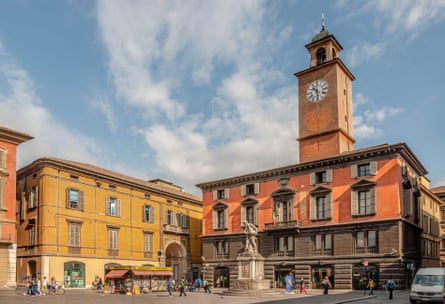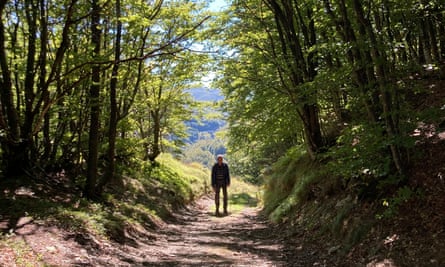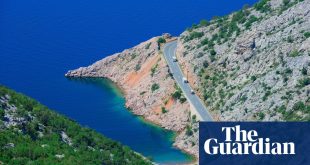“The Ducati trail?” My husband was suddenly excited. “Do we get to ride motorbikes?”
I had to explain that the “Ducati” in Sentiero dei Ducati, a new hiking route being promoted by Italy’s Emilia-Romagna region, refers not to the high-performance bikes made nearby, but to the medieval duchies that once ruled north and central Italy. And far from eating up miles on a sleek machine, we’d be trekking along centuries-old footpaths that once linked ducal territories in this hilly land rising to the high Apennines.
Central Italy’s best-known walk, the Via degli Dei, has been a victim of its own popularity: about 300 people a day now tackle the 80-mile route between Bologna and Florence. But the Sentiero dei Ducati, farther north-west, promised silence, empty paths and wild land with not another human in sight. Starting in leafy Reggio Emilia, less-visited neighbour of Parma and Modena, it runs for 125 miles to Sarzana, near the Ligurian coast.

The website sentierodeiducati.it offers GPS, transport and accommodation listings (doubles from €70), but for a little pre-trek luxury we stayed at the 16th-century guesthouse of the Venturini Baldini wine estate, south of Reggio. While pricey, it’s handy for the trail – a path from its gates joins it via Roncolo country park. (La Maddalena restaurant in nearby Quattro Castella has rooms from €80 B&B.)
Just a few miles of off-road walking in green hills brought us face to face with the lady whose story would dominate much of our trek: Matilda of Canossa. A bit like Elizabeth I, she was red-headed and formidable, holding territory that also included Lombardy and Tuscany. The Italian for “eat humble pie” is andare a [go to] Canossa, after the time in 1077 when the Holy Roman Emperor Henry IV sued for peace with the pope in a deal brokered by Matilda.
Bianello castle is the only one still standing of four castles on a row of hills from which Matilda’s army could control vast lands. Like a medieval internet, hilltop beacons could send messages as far as Tuscany in 15 minutes.
Most interesting for me, though, was what was brewing inside the castle: balsamic vinegar. The commercial product is now sold worldwide, but these hills are its home, and the non-profit Balsamic Vinegar Brotherhood uses its attics to make vinegar the time-honoured way. We followed master Giancarlo up the winding stairs, the smell getting stronger with every step. The first historical evidence of a precious vinegar produced in the area is in a poem by the 12th-century monk Donizo of Canossa, who was also Matilda’s biographer.

These rooms were once jail cells – boiling hot in summer and freezing in winter, to make life miserable for prisoners. But fluctuating temperatures help vinegar achieve its density and character. Showing us flights of five or six barrels in decreasing sizes, Giancarlo told how pressed juice is reduced, fermented then poured into the largest barrel, with its little opening at the top. Over years it’s decanted into ever-smaller barrels of different woods as the “angel’s share” evaporates. Oak, chestnut, cherry, acacia and mulberry woods all add their own flavours. (A juniper barrel gives, unsurprisingly, a gin note.)
A red label denotes 12-year-old vinegar, silver 25 and gold 50. Sipped from a teaspoon the 25-year version exploded with complex flavours, perhaps plum, treacle, chocolate, something smoky? We had to find room in a rucksack for one small bottle.
Balsamic made in Reggio province is regarded as just as authentic as that from Modena, and less acidic. It’s eaten as often on cured or grilled meats, fish or chunks of parmesan as on salad. To keep the tradition going, the confraternità mends people’s leaking barrels, and even buys them from anyone who no longer has time or inclination. “We can’t leave it to commercial producers who make thousands of litres a day,” said Giancarlo.

The trail, waymarked with “SD” and a castle, leads south from here to ruined Canossa castle. A steady climb from there took us to the top of 690-metre Monte Tesa, and a high meadow with views south over miles of Apennines, and north across the Po valley to the Alps. At our feet wild cyclamen peeped from the grass.
Our guide, Matteo, told us that in medieval times most people lived in high places because the plains were all tangled forest or malarial swamp; now the uplands are abandoned, and plains are full of towns, farms and factories.
after newsletter promotion
In a sunny September the paths were clear and easy to follow – often on a ridge, with views to both sides. And while pristine countryside makes for gloriously peaceful walking, shops and restaurants are few and far between: we needed packed lunches. For overnights, wild camping is legal in most of Emilia-Romagna between sunset and dawn, and at least 200 metres from an official campsite.
Covid meant the end of some remote hospitality businesses, but an increase in tourism jobs is slowly bringing young people back. There are tax breaks and funding for new businesses in mountain communities. The once-abandoned village of Vercallo offers holiday lets and e-bike hire, and in Barazzone, the social project Libera Osteria (weekends only) does revered local dinners of, say, wild mushroom soup, filled pasta and hare braised with olives.
For our second night, we headed a few miles off the trail to Madonna della Corte (doubles €90 B&B), an agriturismo presided over by Matilda herself (almost). Its owner, Elisa Montruccoli, plays the lady in reenactments and she and her husband run medieval evenings, with music, feasting and an appearance by the “queen”. Our feast included chard on toast, cured meats and cheeses with chilli sauce and gooseberry chutney, mushroom risotto and roast pork.
The next days took us from rolling foothills into mountains proper. The only person we saw was an old woman collecting mushrooms. I asked her if she’d had a good day. She shook her head sadly: “Poco, poco.” Matteo smiled. “Country folk never admit to knowing a good spot for funghi. She’s probably got kilos.”

After an ear-popping climb from Miscoso, we took a high-level path through spectacular beech forest crossed by streams easily forded in late summer. Not only were we the only humans for miles, there was no sign of human activity. The sunlight was golden, the only footprints were deer’s, and the beech mast underfoot smelt rich and sweet.
We arrived at Rigoso, a 1,131-metre-high village that had been dying on its ancient feet but has been revived with EU and Unesco funds, and the efforts of a community cooperative.
We lunched in the square on local cheese and sausage, then testaroli pasta (pancakes cut into diamond shapes) with pesto. Manuela Gaiani, vice-president of the Corte di Rigoso coop, told how seven local people had got together to reopen the village shop, which had survived Covid. Today Rigoso also has two B&Bs and a bar/restaurant.
From here it’s pretty much downhill to the trail’s end at Sarzana, and trains to La Spezia and home. We’d escaped the crowds to walk a different Italy – undeveloped, sometimes struggling, always hopeful. It would have been a crime to do it on motorbikes.
The trip was provided by the Emilia Romagna tourist board
 Top Naija News: Nigerian News, Breaking News Nigeria and World News Top Naija News is a daily news publication in Nigeria, delivering the latest breaking news in Nigeria and around the world.
Top Naija News: Nigerian News, Breaking News Nigeria and World News Top Naija News is a daily news publication in Nigeria, delivering the latest breaking news in Nigeria and around the world.



